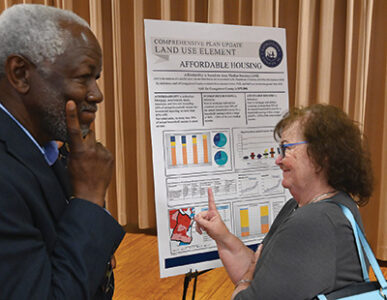Housing
County looks for balance between affordability and preservation

In a conventional subdivision, 154 single-family lots fit on a tract of raw land.
A conservation subdivision would cluster the development in the middle of the tract, preserving the trees at the rear and leaving open space between the homes on the main road along the front of the property. It would create 59 single-family lots around 32 multi-family buildings.
The project doesn’t exist. It was an example that Jake Petrosky, a community planner who is helping the county update the land use element of its comprehensive plan, used to illustrate ways to preserve the character of existing communities in the face of development.
But it also raised questions about how to make housing affordable while still protecting the natural and cultural resources that residents across Georgetown County say they value.
“If you do it right, development on the right can be cheaper than development on the left,” he told county officials at a workshop this month.
“I might take exception to that,” County Council Member Bob Anderson said.
The conventional subdivision on the left had 40 percent more dwellings than the conservation subdivision on the right, he noted. And the price that a developer would pay for the raw land would be the same in either scenario.
While there are fewer lots, a “density bonus” could increase the number of total units, Petrosky said. Allowing each of the multi-family buildings to have three units would bring the total to 155.
“This is just here to represent a concept,” Petrosky said.
A density bonus – allowing more units than the zoning would normally permit – is used in many areas as an incentive for affordable housing, which has risen to the top of the issues for the county’s comprehensive plan. It features in three of the 10 elements that state law requires in the plan: housing, land use and economic development.
At the same time, the draft plan that the consultants were due to present this week and that is now expected to come up for public review in December focuses on ways to preserve the character of the county through improved design and land conservation.
“When it comes to policy, you want to balance things,” Petrosky told county officials.
Council Member Raymond Newton sees the balance shifting away from affordability.
“We’ve been beaten up” over affordable housing, he said. “Everywhere we go, that’s all we hear.”
Newton cited an amendment to the tree protection regulations in the zoning ordinance as a barrier to affordability.
“Just that one item increased the cost of building in Georgetown County,” he said. “Impact fees is another big cost of building a home.”
The county is due to approve an update to the impact fee ordinance that was adopted in 2009. It also charges a separate fire impact fee.
Newton also pointed out that the design for affordable housing that the public rated highest at a series of workshops also looked like the most expensive.
“Affordable housing is easy to say, but it’s a monster mountain to climb,” Newton said.
The consultants, led by the Columbia-based firm Boudreaux, divided the county into five areas to review existing land use and growth potential. The Waccamaw Neck is one. The others include the area around the city of Georgetown and rural areas to the south, west and north.
Council Member Stella Mercado pointed out that the metric used to determine affordability, known as “area median income,” is different across the county. The Waccamaw Neck, with higher average incomes, skews the county average. She suggested using the AMI for each of the five areas in the study to determine what qualifies as affordable.
“We need to define affordability better,” Petrosky said. “I could just be giving you a discount on market rate townhomes, and that’s not going to be helping anybody.”
That’s an argument raised by opponents to four townhouse projects in the Pawleys Island area that are facing court challenges. One of those projects, on a site once proposed for a tech park, promised to rent some units below market rates for a limited period.
Affordable housing isn’t just low income housing, said Ryan Bland, a senior planner at Boudreaux. It includes workforce housing for existing workers and new industry. He cited a housing study commissioned by the county that showed a need for 670 new rental units and 2,200 for-sale units needed by 2025.
There are wider benefits from affordable housing that allows people to live where they work. “It takes some pressure off roadways,” Bland said.
Also part of the housing mix is providing options for seniors who want to downsize without moving from their community, he said.
The impact fee schedule that the council is due to adopt in December actually reduces the cost for most residential development. It exempts mobile homes and housing for people who make less than 80 percent of the county’s AMI entirely.
The current fee for residential construction is $3,844 regardless of the size of the dwelling. The new fees are tied to the square footage. Only dwellings over 4,501 square feet would pay equal or higher fees.
Newton was one of two council members who voted against the change at second reading this month.
He said he was concerned that it would deter economic development.
The fees are designed to offset the cost of capital improvements required to serve development. Under state law, they must be tied to the actual impact on facilities and assessed equally.
The fees will fund roads, law enforcement and recreation facilities.




